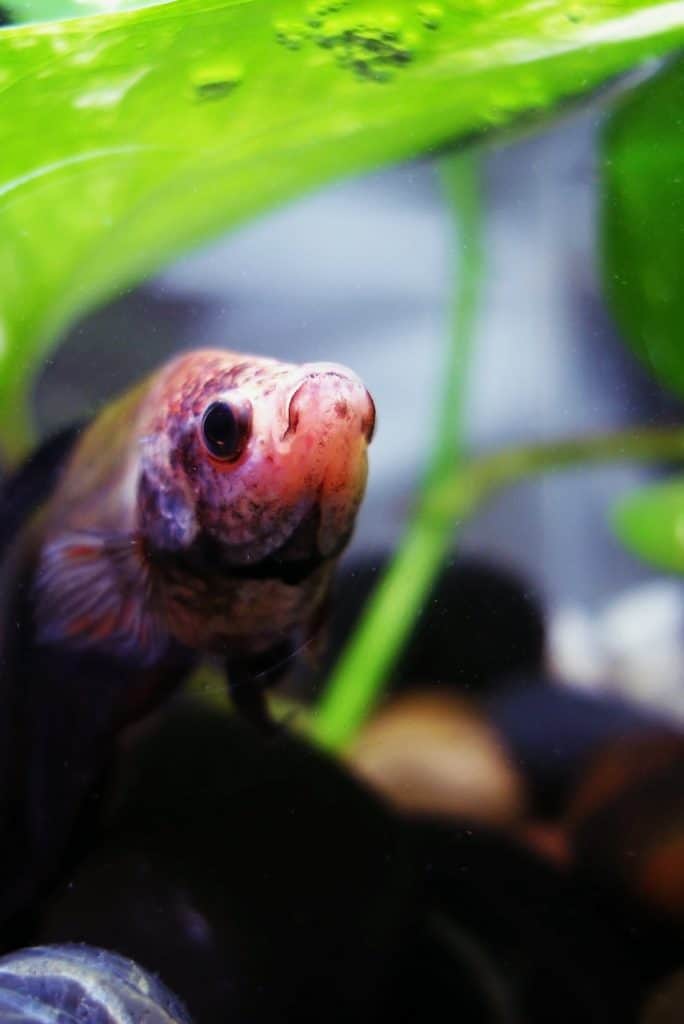So you have your aquarium, water and a betta fish swimming in all this open “space”. While some people really like a minimalistic design, betta fish don’t really dig it too much. There are really quite a few options you can explore in sprucing up your betta’s tank with all sorts of aquatic furniture. But looking at live plants for your betta fish may actually be beneficial in the long term. For both you and your betta buddy.
Why Go for Live?
Live aquatic plants give your betta fish a very natural and home-style setting. They can provide natural hiding and resting spots, which in turn, will help your betta live stress-free. There’s also a certain amount of playful stimulation your betta will get out of having those live, moving plants. This keeps betta fish boredom at bay. It’s also a lot more entertaining for you to watch an active and playful betta rather than one that… isn’t.
On top of that, there are also some natural health and ecological benefits you will gain out of maintaining live aquatic plants. If the plants and aquarium are properly set up together and taken care of, the plants can help reduce some types of aquarium pollution and even introduce wanted nutrients. These benefits are unique to live plants. So while they might require a bit more effort to maintain, they pull their weight a bit more than silk plants.
PSA: Never buy plastic plants for your betta fish. The sharp edges can end up cutting or otherwise harming your fish! If you can’t maintain a live plant, opt for silk.
Best Live Plants for Betta Fish
Java Moss
Java Moss is sometimes regarded as the easiest aquatic plant to raise and care for in a betta’s aquarium. You can get away with any type of betta tank set-up and have this aquatic plant stay strong and healthy on its own. Owners of this plant have kept Java Moss in an isolated, unwatched container with nothing in it except water. Even then, the plant appeared as if it’d been growing with perfect lighting and fertilizer. Java Moss is beyond easy to care for.
Because this is a moss, being mindful of the temperature is the only thing to watch out for. Ideally, mosses prefer cooler temperatures than you should have your betta tank set to, but will still be perfectly fine in a betta temperature environment. In case you forgot, Betta fish need their aquarium to be 78-80 degrees.
If you choose to use Java Moss in your betta’s aquarium, be sure that you keep the rhizome above the gravel or substrate. The Java Moss rhizome is that thicker part of the stem just above the roots. The Java Moss can die if the rhizome is covered.
Java Fern
Java Fern is also very easy to take care of and grow. Actually, Java Fern is more than easy. You can grow entirely new Java Ferns by plucking off one of the leaves. If you let some of the plucked leaves float around in an aquarium, after a few weeks you will start to see new Java Ferns growing from them.
Java Ferns also have a rhizome that you have to be careful not to bury in the gravel. The rhizome is that horizontal, green stem that the roots are attached to. As a simple rule, only plant the part of the plant that is brown. Brown generally means roots, at least in this case.
If you find that you are having trouble planting these Java Ferns (as in getting them to stay planted), you can try the bottle cap trick. Take a bottle cap and punch a hole in it. Stick some fishing string through the hole and tie a knot, so the string can’t pass through the hole. Tie a loose loop or lasso of sorts between the leaves of the Java Fern. Plant the bottle cap in the substrate and your Java Fern shouldn’t travel anymore!
Amazon Frogbit
Amazon Frogbit is yet another easy keeper. This plant resembles lily pads that float on the surface of the water. Because of that, you want to make sure they don’t ever cover too much of the surface. Your betta needs to be able to reach the air above to breathe properly (trust us on this one).
Really, the only trick to keeping Amazon Frogbit healthy is to make sure that the tops of the leaves are kept dry. For some strange decision in evolution, if the surface of this aquatic plant becomes wet, the plant will start to rot. Because of this, you need to be a bit careful when changing the aquarium’s water. Also make sure that the water filter, if you have one, isn’t splashing on the plant.
If your betta has snails as tank buddies, you may want to keep a watch on the snail population when keeping Amazon Frogbit. Snails really enjoy eating the undersides of this particular plant. It’s not so much of a concern when you only have a few snails in the tank, but if your aquarium is teeming with them, you may not want to choose this plant for your betta’s tank.
If you do combine these with your snails, try to corral these plants in the middle of the aquarium, away from the sides. This should help keep the Amazon Frogbit’s bits away from the snails.
(P.S. Amazon Swords are also a popular option for those of you with larger tanks–5+ gallons)
Anacharis
Anacharis is a great plant for betta tanks. This plant can be planted or left alone to just float. That means you can have this one even if you don’t have a substrate in your tank!
Anacharis can and does grow roots though. The roots take quite a while to grow out which makes it difficult in some situations to keep down in one place. Some people choose to use weights of various types to keep this plant in place. (You can use the bottlecap trick on this one too).
One of the cool ways to use this plant is to have it grow at the back of the aquarium and cover the aquarium’s wall. That sure beats any of those cheesy aquarium wallpapers you can buy in the store.
Anubias Nana
Most betta fish love Anubias Nana! These plants have huge, broad leaves that make perfect chairs for bettas. In fact, there’s a lot of betta specific plastic aquarium furniture made to look like the Anubias Nana because bettas really enjoy getting their siesta on with them. These are a great addition to your betta’s aquarium!
With these plants, like some of the others listed here, you do have to be careful about not burying the rhizome as it could kill the plant. The rhizome on this plant is large and round, located right at the base of the plant. It is the part that has both the roots and the leaves growing out of it. It’s one of those “you’ll know it when you see it” kinds of things. You can’t miss it.
The roots of the Anubias Nana grow slowly but firmly around anything you set it on top of. Some people “plant” it on top of freestanding rocks and driftwood submerged in the betta’s aquarium. Wherever you decide to plant Anubias Nana in your aquarium, you will find your betta there shortly after!
Marimo Moss balls
Marimo Moss-balls are just plain cool looking! That, and they are extremely easy to keep and maintain. In general, they serve no real great purpose other than cosmetic.
Marimo’s don’t dirty up your betta’s aquarium with algae. The Marimo Moss balls actually do clean your betta’s tank a bit by using some of the free-floating particles as a food source once decomposed. But they won’t be doing enough cleaning to beat a filter and regular water changes. So, yes, they do “clean” a bit of the pollution, but they are no substitute for regular aquarium maintenance.
An interesting thing that you can do with Marimo Moss balls is that you can break them apart, roll them into smaller balls and they will continue to grow! If you would like to try this, look for a “seam” on the Marimo and gently pull apart from there. Roll the pieces into a ball shape between your hands and place them back in the betta’s tank. Granted, you may end up losing some, but in general, they should slowly grow into bigger versions of themselves.
Hornwort
Hornwort is a great plant for your betta’s tank, but only if you have the time to keep up with it. You pretty much can’t kill this plant and it really doesn’t need any special attention to really grow, really fast.
Hornwort is on this list because it is super easy to grow. The drawback to this plant, however, is that it can easily “grow” into a problem well-kept.
One of the great things about this plant is that it does a good job at removing nitrates and ammonia from the tank. The trade-off to that is that it uses what it removes to quickly grow. If left alone for too long, you will end up with your aquarium filled with the plant and its sheddings. Being that it does tend to shed a lot, you may find that you need to clean your filter much more often.
What Not to Get
Duckweed
Duckweed rests on the surface of your aquarium as does the Amazon Frogbit up above. The “leaves” are much smaller, and the growth rate is practically uncontrollable. Duckweed is practically impossible to get rid of once “contracted”.
You can have 5 different betta tanks, plant this in one of them and then weeks later, find it somehow spread to the other 4 tanks. Duckweed will dry on and in anything that you use in and for your aquarium. Things like your nets, gravel, and brushes. Duckweed is something you do not want. In all seriousness, Duckweed will end up killing your betta.
Peace Lilies
Plenty of bettas are actually sold with peace lilies in their “tanks” (usually more like small vases or bowls). However, these (along with most other plants used like this) aren’t a great option for your fish. Aside from the fact that this “look” relies on keeping your betta in an inappropriate environment (no, a vase is not an OK tank setup), non-aquatic plants just aren’t really the way to go.
Eventually, these plants can rot and decompose, negatively affecting the pH and other important ecological factors in your tank environment. The same thing goes for other non-aquatic plants like bamboo, which aren’t really intended to be paired with water.
Wrapping Up
So there you have it! Those are our top (and bottom) picks for what plants should go in your betta tank. Opting to plant or float some live plants in your tank can be an excellent source of enrichment for your betta and the tank environment. Just make sure to do some research on proper upkeep and the like before committing to one. That way, both your plant and your betta can lead happy, healthy lives.















